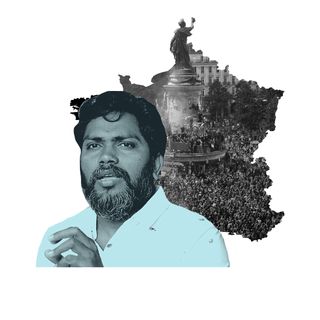
Voyeur Nation
National interest in the exact volume of an unspecified liquid substance in a dead woman's vagina speaks to a necrophilic veneer on public outrage.

Shortly after news of the RG Kar College doctor's rape and murder broke, details allegedly from her postmortem went viral. The country was informed of the number of milliliters (150) of what appeared to be semen that was found in the dead woman's dead vagina. The figure was the focal point of a template story on Instagram, which it claimed made a forensic case for calling it gang-rape (the average male produces only about 15 mL of semen, it stated). There was also the fact that her legs were allegedly splayed at a 90-degree angle — irrefutable proof that it wasn't just any rape, it was violent rape ("she was torn apart," the template story continued, in red font). We learnt what a "pelvic girdle" was, and at what angle it might break. Then, it was only a matter of time before images of the dead body itself surfaced on social media — and given everything we knew already, the picture formed itself.
This was until journalists debunked the 150 mL semen hypothesis. The postmortem merely mentioned the weight of the vagina, as postmortem reports usually do, according to new reports. The reference to a white liquid in the vagina didn't imply that it was semen. So now, we not only know the state of the vagina (bleeding), but also its contents (unspecified white liquid), and also its weight. In other words, we know too much — more than we have a right to.
It would seem that the choice of what crimes are covered by newsrooms — and now, social media accounts — depends on a single shocking detail that makes it stand out. In the Nirbhaya case, it was the use of an iron rod in the assault that mobilized mass protests. In the Hathras case, it was the victim's tongue being cut off. And in the RG Kar case, it is the speculation around the semen. There's a term for the pattern of selecting cases to cover based on such details: "rape exceptionalism," as one analysis puts it. This has deleterious effects for the health of public discourse: in the RG Kar case, for instance, the issue of workplace safety and labour rights was overshadowed by coverage of the victim's autopsy report — thereby pulling focus back onto her body and what others have done to it.
The Dalit Caste Identity of Hathras Victim Is Vital to Recognizing Her Rape as a Casteist Crime
The nature of news cycles is that they move fast and they move on. The RG Kar case is already old news. "Reclaim the Night" protests have died down too. Even as expert committees are formed and task forces are announced (but never fully deployed into action), the actual case slowly recedes from public conversation. They all do after a point — but such voyeurism and the disproportionate emphasis on the body reinforces the ebb and flow of news about rape. And consequently, there is no tangible progress toward systemic changes.
With so much of the media's gaze trained on rape-murder victims' bodies, detailing the exact nature of violation, it's shocking but not surprising that searches for the their names spikes on porn sites. This is arguably the natural consequence of a media ecosystem that blurs the line between sex and violence: using sexually suggestive euphemisms to emphasize the brutality of the violence — before the visceral impact of the news fades out of memory. As many point out, a focus on the sensational details of the case tend to be the peak of coverage, after which very few follow-up stories are commissioned to look into the long process of seeking justice.
A recent analysis of media trends in high-profile sexual violence cases in India found that many reports tend to focus on the graphic details — the state in which the victim/survivor was found, the internal and external injuries inflicted, quotes from the FIR, quotes from the medical reports. The cumulative effect is that the public is privy to grim details of the crime scene, the bodily injuries, and the hunt for the unknown perpetrator.
One thing stands out clearly: the media’s focus on grievous details is the influence of a retributive justice narrative. As a Berkeley Media Studies Group report shows, law enforcement and police are the most cited sources in stories about rape. The template of the story is: innocent victim, monstrous perpetrator, grievous injuries, swift and protectionist justice. It individualizes the crime — preoccupying the public with the cause and outcome of one particular case, using voyeuristic details of the victim's body as a catalyst to drive the story.
But as decades of feminist scholarship has pointed out, rape is systemic and the criminal justice system is not only inadequate, it is also part of the problem. The practice of scrutinizing the extent of harm inflicted on a victim's or survivor's body is rooted in criminal justice methodology, where these very details are furnished and assessed as evidence for the rape accusation. The Mathura case of 1971, in which police officers raped an Adivasi minor in custody, shows how the legal system's gaze on the body can be weaponized against survivors. In that case, Justice A.D. Koshal ruled: "No marks of injury were found on the person of the girl after the incident and their absence goes a long way to indicate that the alleged intercourse was a peaceful affair, and that the story of a stiff resistance having been put up by the girl is all false." This case was the basis of changes to the Indian Evidence Act, which made it punishable to disclose the complainant's identity and presumed that consent was absent if the victims says so — but only in cases of custodial rape.
News Reporting of Sexual Violence Is Propagating Rape Culture
The feminist scholar Veena Das further observes that courtroom rape trials employ a judicial grammar that turns a survivor's verbal testimony against their own bodies. In the process of determining whether rape has indeed occurred, it is often the body that the court returns to as a site of evidence to prove or disprove what the survivor is saying. The body further acts as evidence for determining the woman's character, as the Mathura case shows. This, coupled with the fact that the law does not recognize marital rape in India as rape, in turn frames rape and sexual violence not as a violation of bodily integrity but as a property violation. As Das puts it, rape offends “not the body of the woman but the order of correct sexual relations as defined by societal norms.” The cases of "stranger" rape are reported with such gratuitous detail to emphasize the magnitude of wrongdoing when an "outsider" rapes a woman — as opposed to someone who might have legitimate ownership over her.
A 2015 analysis of Indian media coverage of sexual violence — in the aftermath of the Nirbhaya case — found that cases perpetuating the idea of the unknown "outsider" or a "devious monster" as the perpetrator tend to receive more coverage in the form of "carpet journalism," whereas cases of abuse and violence within families don't.
In cases where the victim is killed, then, the bodily evidence of the extent of violence furthers the notion that rape is irrefutable because the body is battered — and the victim is dead. In other words, when the public overwhelmingly focuses on the body of the victim, it reiterates the notion that the only way for a person to be a legitimate victim of rape is in death. But at this point, the victim goes through a second violation: that of their privacy, thanks to the necrophilic voyeurism about their genitals and the semen found in the post-mortem.
The conversation around the Hema Committee Report in the Malayalam film industry and many stakeholders' continued insistence on "false accusations" speak to this tension between the body and a survivor's own testimony when it comes to sexual assault and violence. In the case of the actor Dileep accused of orchestrating the abduction and rape of another actor, Dileep insinuated that a true victim would have died by suicide or otherwise suffer from "mental issues" — still more evidence of the fact that, in rape, the only legitimate victim is perceived as one who cannot talk but who undergoes some form of irreversible bodily damage.
The public’s hunger for details, then, boils down to this: only permanent damage, forensically verified, is worthy of not just our outrage but our belief in the fact that harm has taken place.
Rohitha Naraharisetty is a Senior Associate Editor at The Swaddle. She writes about the intersection of gender, caste, social movements, and pop culture. She can be found on Instagram at @rohitha_97 or on Twitter at @romimacaronii.
Related


Julian Assange, Delhi's Climate Crisis, and Parisian Protests
